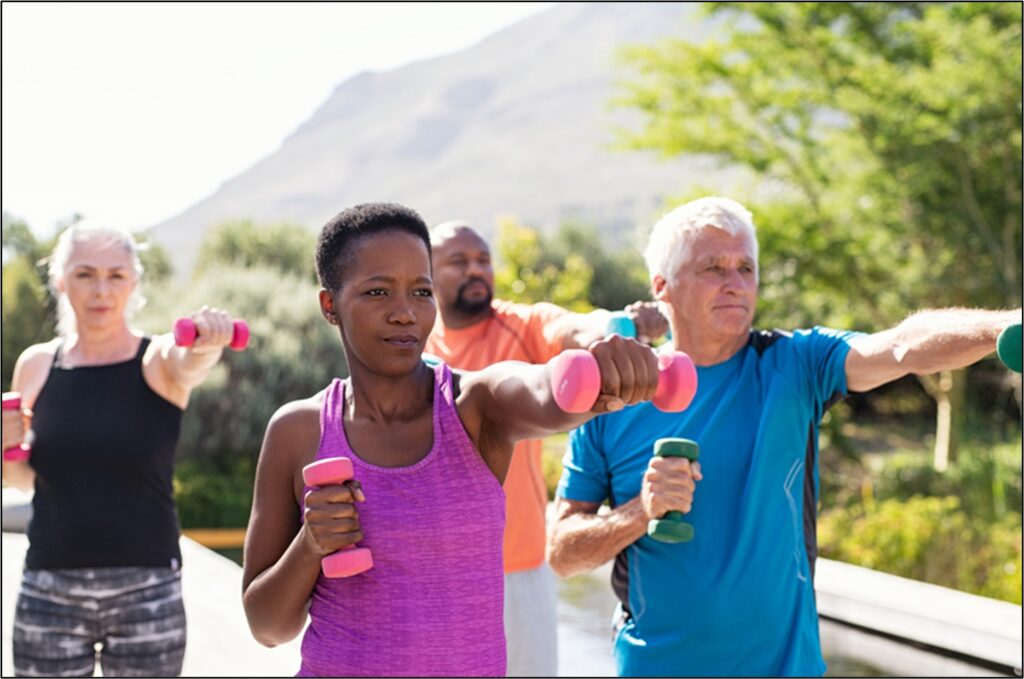

Build the Mindset for Fitness Success
- by Life Priority
- No Comments
- Post Views: 83

One of the great things about getting older is this: By now, you’ve learned how important it is to have the right mindset in building a new habit or working toward a goal.
Right? You’ve done this countless times throughout life, whether at work, with your family, or pursuing hobbies. You know that:
- If you have the wrong idea, you’re starting on the wrong foot.
- If you listen to the naysayers, you’ll never get anywhere.
- If you focus on impossible dreams, you won’t achieve your perfectly attainable desires.
So, here is our list of five common mistakes people over 50 make about fitness. Join us today and let’s break free together!
Looking Back (Waaaaaay Back)
Men in their 50s and 60s will tell us on their first visit, “When I was in college, I could bench press a truck while running the 4-minute mile. On a hangover. So, yeah, let’s get me back to that.”
WRONG.
It doesn’t matter what you think you did decades ago, good or bad. Life didn’t end at 25, did it? We figure out your abilities TODAY and how they relate to your desires for TOMORROW.
“Why Is This Taking So Long?”
We all want the “quick fix” to our problems, don’t we? It’s only natural.
But let’s not get frustrated too soon. Success takes time.
Here’s a simple example: You didn’t gain 40 pounds in two weeks, so it’s going to take more than two weeks to lose it.
Too Much Focus on Weight
Our culture puts too much emphasis on weight. Here with us, you’ll learn to focus more about mobility, strength, agility and stamina.
And yes, you’ll start looking better in no time, which might (or might not) be accompanied by a lower number on the scale.
But it’s just one little piece of the puzzle.
“It’s Too Late for Me”
Stereotypes and myths somehow persist that health is for young people only, or something we can’t correct or improve.
Nothing could be further from the truth. As we age, it’s even more important to take care of ourselves so we can enjoy independence and a higher quality of life.
We don’t try to make you young again because there’s simply no need for that. (Also, it’s, you know, impossible!) It’s never too late to start exercising and see improvements.
“I Don’t Care About Muscles”
If you come in here with the mindset that you just want to walk on the treadmills for a few minutes, then you’re missing out on the most powerful tool we have to help you live the life you want to live.
And that’s resistance training. Or strength training. Or weightlifting, if you like.
We all need muscle as we go through life. Muscle keeps us upright. It lets us stand up from the toilet. It lets us put away the groceries, travel, and beat the neighbors at pickleball. You simply can’t do anything without muscle, and we’ll make sure you have as much as you need.
We’ll go over all this and more with you before you start – and at any time after you’ve joined us. We’ll get your mindset right, and we’re here to keep it right long after you’ve joined.
Let’s do this!

Regular Exercise Can Help with Problem Drinking
Alcohol abuse can sneak up on us later in life, experts say. Many people lose their partners, job-associated identity, and a sense of purpose that had guided them for decades, and some can develop or worsen a drinking problem.
The pandemic, and the isolation it brought, led millions of older adults to drink more, surveys found.
Now, with the annual Alcohol Awareness Month in April, it’s a good time to point out signs of possible trouble for people later in life. And to share the good news about the positive role regular exercise can play in overcoming a drinking problem.
We don’t metabolize alcohol and drugs as quickly as when we were younger, doctors say. So, what we could “handle” earlier in life can become a problem later.
Exercise can be a helpful part of recovery, along with 12-step programs, counseling, and medical and family support. Potential problem signs include: drinking quickly; hiding consumption; getting hurt while drinking; and a decline in self-care.
“Many patients with various substance use disorders have found that exercise helps to distract them from cravings,” Dr. Claire Twark wrote for the Harvard Medical School. “Workouts add structure to the day. They help with forming positive social connections and help treat depression and anxiety in combination with other therapies.”
> If you have a concern, contact your doctor, counselor or Alcoholics Anonymous, phone (800) 839-1686.

Healthy Recipe, Seared Pork Chops with Grapes and Thyme
Those jumbo bags of seedless grapes sold in supermarket produce sections are handy to have around in the crisper for healthy snacking. But there are other ways you can maximize that fruitful bounty. Grapes pair exceptionally well with pork, as demonstrated in the recipe here, adapted from one on the health.delicious.com website. To stretch that protein, allow the chops to rest while you make the sauce, then thinly slice the meat against the grain. Chances are, you’ll have plenty for another meal. Serves 2-4. RECIPE HERE – Susan Puckett
Ingredients
- 2 thick (bone-in) pork chops, about ¾ pound each
- Salt and pepper
- 1 tablespoon olive oil
- 1 large shallot (or 1 small yellow onion), minced
- 1 large garlic clove, minced
- 2 teaspoons minced fresh thyme leaves (or 12 teaspoon dried)
- 1 cup low-sodium chicken broth
- 1 tablespoon butter (optional)
- 1 ½ cups seedless red or green grapes
Instructions
- Preheat the oven to 400 degrees. Pat the pork chops dry with paper towels and season on both sides with salt and pepper.
- In a large cast iron or other heavy-bottomed skillet, heat the olive oil over high heat. Add the pork chops and cook 3 to 4 minutes per side, or until well-browned.
- Transfer to the oven and roast 5-8 minutes, just until cooked through (145 degrees on a meat thermometer).
- Remove from the skillet from the oven and transfer the chops to a plate to rest. Pour out all but 1 tablespoon of fat from the pan and set it back on the burner.
- Add the shallot (or onion) and garlic; cook and stir until softened, 3 to 4 minutes. Stir in the thyme and cook 1 minute longer. Add the broth, bring to a rapid simmer, and cook until reduced by about a third, or until thickened to a gravy consistency.
- Stir in the butter, if using, add the grapes, and cook 2 to 3 minutes, or until heated through.
- If desired, thinly slice the pork from the bone across the grain and arrange slices on each of 2 to 4 plates, reserving any leftovers for another meal. Alternately, place a whole chop on each of 2 plates.
- Spoon the grapes and sauce over the pork and serve.
Article Credit Jay Croft, creator and owner of Prime Fit Content.
Susan Puckett is a cookbook author and former food editor of The Atlanta Journal-Constitution. Follow her at susanpuckett.com.
Sign up for emails from OneHeartNetwork.com:
By providing your email address, you are agreeing to our privacy policy.
RECOMMENDED




